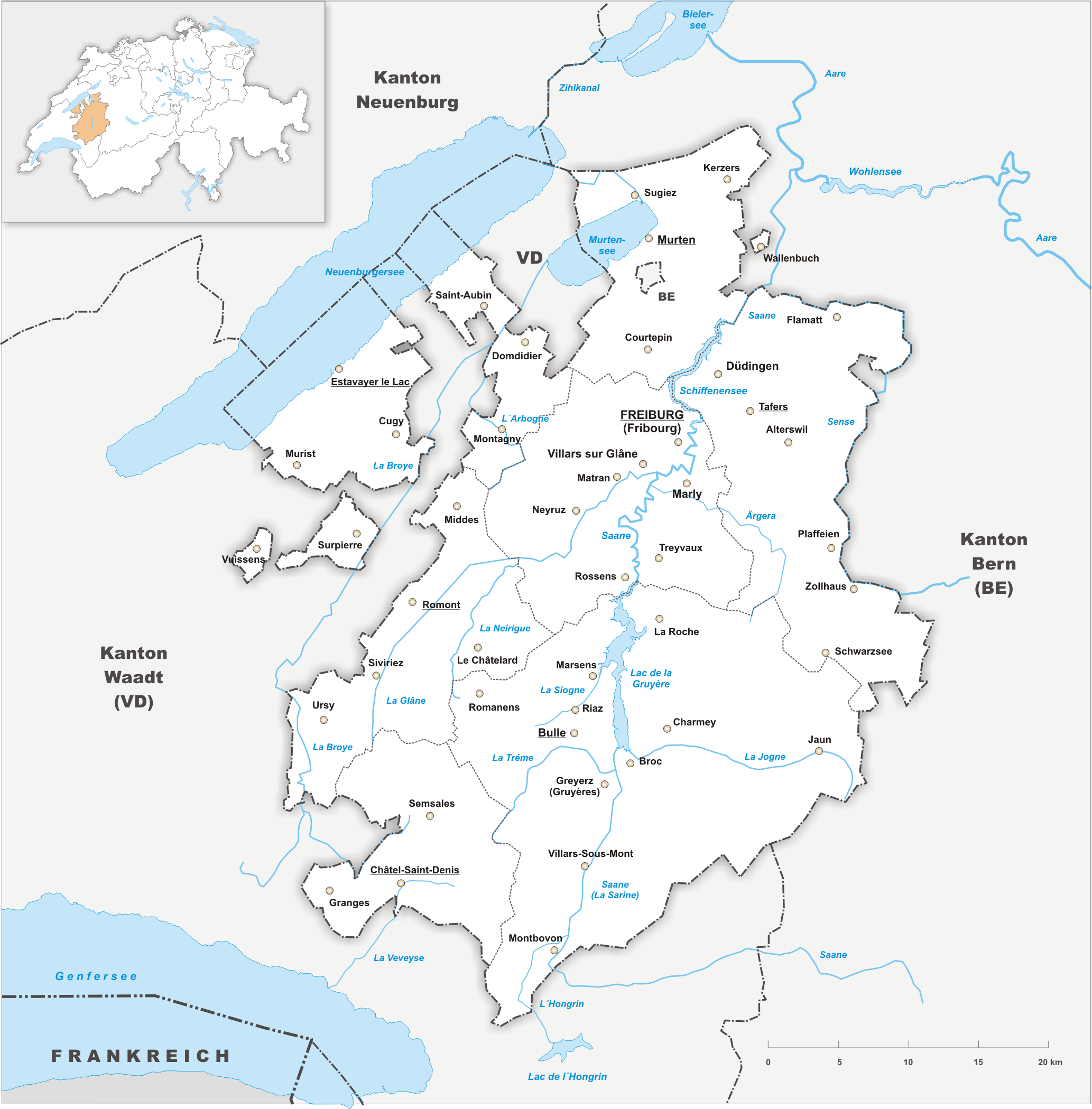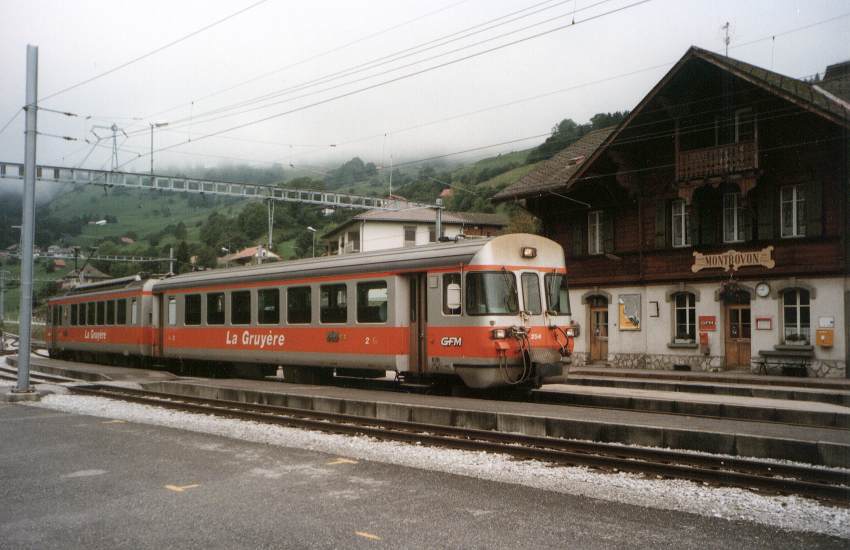|
Bulle–Romont Railway Line
The Bulle–Romont railway line is a standard gauge railway line in the canton of Fribourg, Switzerland. It runs from to . The line is owned and operated by Transports publics Fribourgeois (TPF). History The Chemin de fer Bulle–Romont Chemin or Le Chemin may refer to: Arts and media * ''Le chemin'' (Emmanuel Moire album), 2013 album by French singer Emmanuel Moire * ''Le chemin'' (Kyo album), 2003 album by French band Kyo ** "Le Chemin" (song), title song from same-titled Kyo ... (BR) opened the line between Bulle and Romont on 1 July 1868. The line was electrified on 8 May 1946. In 1942, the BR merged with two other companies to form the Chemins de fer fribourgeois Gruyère–Fribourg–Morat (GFM). The GFM, in turn, became the Transports publics Fribourgeois (TPF) in 2000. Notes References * Railway lines in Switzerland Transport in the canton of Fribourg Railway lines opened in 1868 15 kV AC railway electrification {{DEFAULTSORT:Bulle-Romont railwa ... [...More Info...] [...Related Items...] OR: [Wikipedia] [Google] [Baidu] |
Transports Publics Fribourgeois
The Transports Publics Fribourgeois (TPF) is a renaming of the former Chemins de fer Fribourgeois Gruyère-Fribourg-Morat when the municipal Transport en commun de Fribourg (TF) was absorbed in 2000. Lines The company is a railway operator with both narrow and standard gauge lines centred in the town of Bulle. The main line of the narrow gauge network runs from Palézieux railway station (at Palézieux-Gare), on the SBB main line from Bern to Lausanne, via Châtel-St-Denis and Bulle to Montbovon. The short Bulle - Broc branch, which leaves this line between Bulle and La Tour-de-Trême, serves the nearby Nestlé (formerly Cailler) chocolate factory. The company also operates two standard-gauge lines, between Bulle and Romont and Fribourg - Ins via Murten/Morat. Trains on the latter route have been extended and now operate a regular interval service Fribourg - Murten - Ins - Neuchatel, taking them on to BLS tracks (Ins - Neuchatel). The Palézieux - Montbovon line was ope ... [...More Info...] [...Related Items...] OR: [Wikipedia] [Google] [Baidu] |
15 KV AC Railway Electrification
Railway electrification systems using at are used on transport railways in Germany, Austria, Switzerland, Sweden, and Norway. The high voltage enables high power transmission with the lower frequency reducing the losses of the traction motors that were available at the beginning of the 20th century. Railway electrification in late 20th century tends to use AC systems which has become the preferred standard for new railway electrifications but extensions of the existing networks are not completely unlikely. In particular, the Gotthard Base Tunnel (opened on 1 June 2016) still uses 15 kV, 16.7 Hz electrification. Due to high conversion costs, it is unlikely that existing systems will be converted to despite the fact that this would reduce the weight of the on-board step-down transformers to one third that of the present devices. History The first electrified railways used series-wound DC motors, first at 600 V and then 1,500 V. Areas with 3 k ... [...More Info...] [...Related Items...] OR: [Wikipedia] [Google] [Baidu] |
Canton Of Fribourg
The canton of Fribourg, also canton of Freiburg (french: Canton de Fribourg ; german: Kanton Freiburg ; frp, Canton de Fribôrg rm, Chantun Friburg it, Canton Friburgo) is located in western Switzerland. The canton is bilingual, with French spoken by more than two thirds of the citizens and German by a little more than a quarter. Both are official languages in the canton. The canton takes its name from its capital city of Fribourg. History On the shores of Lake Neuchâtel and Lake Morat significant traces of prehistoric settlements have been unearthed. The canton of Fribourg joined the Swiss Confederation in 1481. The area is made up of lands acquired by the capital Fribourg. The present extent was reached in 1803 when Murten (Morat) was acquired. The canton of Fribourg joined the separatist league of Catholic cantons in 1846 ( Sonderbund). The following year, its troops surrendered to the federal army. Geography The canton is bounded to the west by Lake Neuchâtel, to ... [...More Info...] [...Related Items...] OR: [Wikipedia] [Google] [Baidu] |
Chemin De Fer Bulle–Romont
Chemin or Le Chemin may refer to: Arts and media * ''Le chemin'' (Emmanuel Moire album), 2013 album by French singer Emmanuel Moire * ''Le chemin'' (Kyo album), 2003 album by French band Kyo ** "Le Chemin" (song), title song from same-titled Kyo album *''Le Chemin de France'' (English ''The Flight to France''), an 1887 adventure novel by Jules Verne Places * Chemin, Jura, France * Chemin, Valais, Switzerland * Le Chemin, France, commune in the Marne department in the Champagne-Ardenne region in north-eastern France People with surname Chemin * Ariane Chemin (born 1962), French journalist * Jean-Yves Chemin (born 1959), French mathematician Other uses *CheMin, short for Chemistry and Mineralogy, an instrument located in the interior of the Curiosity rover, that is exploring the surface of Gale crater on Mars See also *Chemin de fer (other) Chemin de fer is a French phrase meaning "railway" or "railroad". Literally, "iron path." Chemin de fer may refer to: Arts, ent ... [...More Info...] [...Related Items...] OR: [Wikipedia] [Google] [Baidu] |
Chemins De Fer Fribourgeois Gruyère–Fribourg–Morat
The Chemins de fer fribourgeois Gruyère–Fribourg–Morat (GFM) was a railway company in Switzerland. It was established with the merger in 1942 of two standard gauge and one gauge railways running mainly within the Swiss canton of Fribourg. It was officially called the ''Compagnie des Chemins de fer fribourgeois'' beim Eidg. Amt für das Handelsregister ("Fribourg Railway Company"). The company also operated numerous regional buses in the same area. After a merger with Fribourg city transport, the company was renamed Transports publics fribourgeois/Freiburgische Verkehrsbetriebe (TPF). The company was created on 1 January 1942 from the merger of metre-gauge Chemins de fer électriques de la Gruyère ("Electric Railways of the Gruyère"; CEG), the standard-gauge Fribourg-Ins Railway (''Chemin de fer Fribourg–Morat–Anet''; FMA) and the also standard gauge Bulle-Romont Railway (''Bulle-Romont-Bahn''; BR). On 1 January 2000, the GFM merged with the ''Transport en c ... [...More Info...] [...Related Items...] OR: [Wikipedia] [Google] [Baidu] |
Railway Lines In Switzerland
Rail transport (also known as train transport) is a means of transport that transfers passengers and goods on wheeled vehicles running on rails, which are incorporated in tracks. In contrast to road transport, where the vehicles run on a prepared flat surface, rail vehicles ( rolling stock) are directionally guided by the tracks on which they run. Tracks usually consist of steel rails, installed on sleepers (ties) set in ballast, on which the rolling stock, usually fitted with metal wheels, moves. Other variations are also possible, such as "slab track", in which the rails are fastened to a concrete foundation resting on a prepared subsurface. Rolling stock in a rail transport system generally encounters lower frictional resistance than rubber-tyred road vehicles, so passenger and freight cars (carriages and wagons) can be coupled into longer trains. The operation is carried out by a railway company, providing transport between train stations or freight customer faci ... [...More Info...] [...Related Items...] OR: [Wikipedia] [Google] [Baidu] |
Transport In The Canton Of Fribourg
Transport (in British English), or transportation (in American English), is the intentional movement of humans, animals, and goods from one location to another. Modes of transport include air, land ( rail and road), water, cable, pipeline, and space. The field can be divided into infrastructure, vehicles, and operations. Transport enables human trade, which is essential for the development of civilizations. Transport infrastructure consists of both fixed installations, including roads, railways, airways, waterways, canals, and pipelines, and terminals such as airports, railway stations, bus stations, warehouses, trucking terminals, refueling depots (including fueling docks and fuel stations), and seaports. Terminals may be used both for interchange of passengers and cargo and for maintenance. Means of transport are any of the different kinds of transport facilities used to carry people or cargo. They may include vehicles, riding animals, and pack animals. Vehicles ma ... [...More Info...] [...Related Items...] OR: [Wikipedia] [Google] [Baidu] |
Railway Lines Opened In 1868
Rail transport (also known as train transport) is a means of transport that transfers passengers and goods on wheeled vehicles running on rails, which are incorporated in tracks. In contrast to road transport, where the vehicles run on a prepared flat surface, rail vehicles (rolling stock) are directionally guided by the tracks on which they run. Tracks usually consist of steel rails, installed on sleepers (ties) set in ballast, on which the rolling stock, usually fitted with metal wheels, moves. Other variations are also possible, such as "slab track", in which the rails are fastened to a concrete foundation resting on a prepared subsurface. Rolling stock in a rail transport system generally encounters lower frictional resistance than rubber-tyred road vehicles, so passenger and freight cars (carriages and wagons) can be coupled into longer trains. The operation is carried out by a railway company, providing transport between train stations or freight customer facilit ... [...More Info...] [...Related Items...] OR: [Wikipedia] [Google] [Baidu] |




